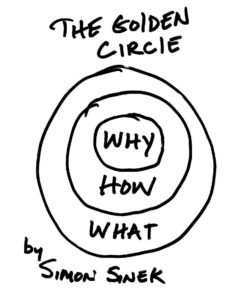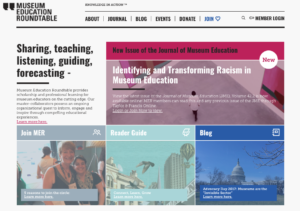Retelling the Story of Museum Education Roundtable
“Sharing, teaching, listening, guiding, forecasting – an ongoing organizational quest to inform, engage and inspire through compelling educational experiences. We are Knowledge in Action. “
These words form the conclusion of Museum Education Roundtable’s recently redefined brand story. More importantly, they mark the culmination of a multi-year project intended to chart a course for our future.
Origins and Background
During the hot early August days of the summer of 2014, the Museum Education Roundtable board gathered in a conference room at the National Museum of Natural History. Expertly led by an Executive Team consisting of Paige Simpson Faulkner, Beth Maloney, and Brooke DiGiovanni Evans, the group embarked on a strategic planning process that critically examined the strengths and potential areas of growth that defined museum education’s longest standing professional organization. Through a series of exercises, experiences, and conversations, themes began to emerge: a recognition that we needed to learn more about our audiences and their motivations for connecting with MER; a concern that the value of our efforts was being clearly communicated to the field; and, finally, a universally shared assertion that it was time for us to re-envision our brand.
In the months that followed, I had the privilege of learning from and working with Paige as she led a task force whose objective was to clarify a course of action to address these elusive, yet integrally important concepts. The process we undertook required the unique skill sets of every member of our team. Jennifer Caleshu conducted a massive-mixed method survey using an instrument specifically designed to help us understand who we were reaching and why they were engaged. Her in-depth study of the data led to a report showing us that “advocate,” “informative,” and “sophisticated professional support” were the words our audiences most closely connected to us. We also learned that the top five reasons our respondents gave for joining MER were:
- To stay on top of trends in the field
- To gain knowledge about museum education
- To receive a physical copy of the Journal of Museum Education
- To support peer-reviewed scholarship in the field of Museum Education
- To feel part of the Museum Education Community
Starting with Why
Armed with this insight, a small group including Karleen Gardner, Heather Johnson, and I set to work on using the perspective we had gained to re-articulate MER’s mission statement. As you might imagine, the task ahead of us seemed huge. How could we create a statement that distilled the countless conversations that we had, as well as a 40 plus year history, into a concise and inspiring sentence or two?
 We looked to business theorist Simon Sinek and his concept of the Golden Circle as a jumping off point for moving forward. In his seminal book, Start with Why, Sinek recounts how most organizations introduce themselves by stating what they do – whatever product, service, or experience they offer to the customers they serve. From there, they often describe how they make these products – their methods of development and sources of materials. However, most miss the mark by never explaining why they are doing what they do. The most successful brands, he argues, do the opposite. They lead with the very reason they exist – the purpose that gets their teams out of bed in the morning, the difference they are trying to make in the world. Then, they describe how this will happen and finally what they produce.
We looked to business theorist Simon Sinek and his concept of the Golden Circle as a jumping off point for moving forward. In his seminal book, Start with Why, Sinek recounts how most organizations introduce themselves by stating what they do – whatever product, service, or experience they offer to the customers they serve. From there, they often describe how they make these products – their methods of development and sources of materials. However, most miss the mark by never explaining why they are doing what they do. The most successful brands, he argues, do the opposite. They lead with the very reason they exist – the purpose that gets their teams out of bed in the morning, the difference they are trying to make in the world. Then, they describe how this will happen and finally what they produce.
Multiple iterations of a new mission statement were authored by our taskforce. Numerous evaluations occurred. In the end, the outcome reached by the board was to move . . .
FROM the existing mission statement which read:
Together realizing connections on the pathways to best practices
TO the recently adopted version which reads:
Museum Education Roundtable inspires innovative thinking for the field (why) through engagement with scholarly and practiced-based content (how) explored in the Journal of Museum Education (what).
We also added a vision statement intended to describe what would happen if we did our jobs to the best of our ability:
Empowering museum educators to transform the field through learning, community building, and innovative practice.
Time to Get Creative
Riding the wave of these important first steps, the time was right for the real fun to begin. The strategic plan, completed and adopted in early 2016, called for a Request For Proposal process to enlist the support of professionals who would sustain the forward momentum by guiding us toward a reimagined brand. We were fortunate to receive responses from firms across the country that were eager to help channel our passion into a new image. Over time, we all agreed on Hollis Brand Culture as exactly the collaborative, creative partner who would push us to step up our game.
Vivian Haga, Board Member at large, had worked with Don Hollis, the firm’s principal, and his team of visionary storytellers on a project for the Museum of Photographic Arts in San Diego. She recommended them highly and assured us we’d be happy with the results. So, I was beyond excited to join a project team consisting of Don and his co-workers, Dawn Vitale and Kendall Connors, as well as Brooke DiGiovanni Evans (MER’s President), Claire Smith (MER’s Marketing Manager), and Samantha Norton (MER’s Treasurer – who made sure all the bills were paid!).
Knowledge in Action
 By now you have may noticed that things look a little different around MER. Over 10 months, our team collaborated to define and launch the new brand, which is observable on our completely re-designed MER website. Through countless conference calls, debates about the big ideas, conversations about different fonts, color schemes, and photo choices, we sought to create a package that captures our essence. From a visit by Don at the board’s annual meeting in Washington, DC (August 2016) to website reviews as we prepped for our big launch at AAM in St. Louis, we considered every detail in our quest to get this right.
By now you have may noticed that things look a little different around MER. Over 10 months, our team collaborated to define and launch the new brand, which is observable on our completely re-designed MER website. Through countless conference calls, debates about the big ideas, conversations about different fonts, color schemes, and photo choices, we sought to create a package that captures our essence. From a visit by Don at the board’s annual meeting in Washington, DC (August 2016) to website reviews as we prepped for our big launch at AAM in St. Louis, we considered every detail in our quest to get this right.
So much more than just the new logo and sharp-looking website (which we’re quite proud of!), we have been using the following definitions to guide our work:
“Your brand is the sum of the experiences that you deliver to customers.”
“Your brand is a singular idea or concept that you own in the mind of your audience.”
With this in mind we hope that our new brand package encourages you to see the Journal of Museum Education, the reader guides that we produce, our programs and events, and any other interaction that you have with our organization as an opportunity to enhance your practice through the innovative ideas that we share. The quotation marks in our new logo are a call to action – use the Journal of Museum Education as a source for an impassioned, life-long journey of learning! Engage in critical dialogue and conversation about the important concepts and themes that MER presents. Refer to the Journal as a reference and source for the changes you seek to make at your institutions.
The merging of theory and our day to day experiences is an association that we hope you will make through the lens of our new look and feel. “Knowledge in Action” is our promise to you. We look forward to collaborating with you, now and in the future, to push our field to new heights through “learning, community building, and innovative practice.”

_____________________________________________________________________________
Jon Carfagno joined the Hickory Museum of Art as the institution’s fifth Executive Director in April 2017. Prior to that he served as the Director of Learning and Audience Engagement at the Grand Rapids Art Museum where he led numerous initiatives that brought local, statewide and national recognition to the museum. Jon currently serves as the Vice President of the Board for the Museum Education Roundtable. A frequent speaker on the topics of human centered design, methods of innovation, and organizational theory, Mr. Carfagno is most actively concerned about diversity, museum futures, and sustainability. He holds the M.A. in Art History with a Distinction from the University of Massachusetts and completed Kendall College of Art and Design’s MBA Certificate Program in Design and Innovation Management.

